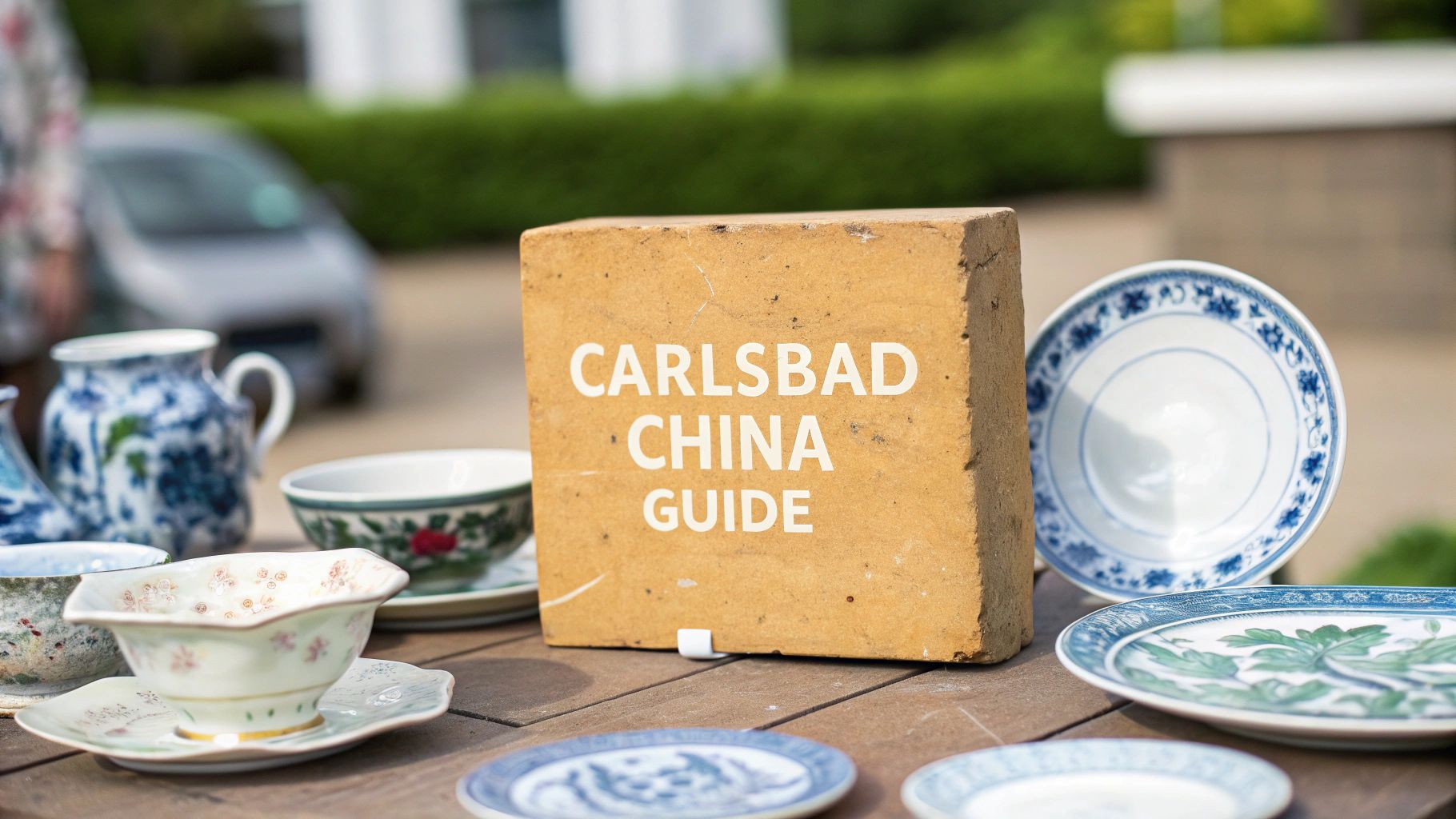When you hear the term "Carlsbad Austria china marks," it’s easy to think it refers to a single, specific company. But that’s not quite the case. Instead, think of it as a stamp of origin—a historical "Made In" label that tells you the piece came from a region celebrated for its incredible porcelain.
This area, which we now know as Karlovy Vary in the Czech Republic, was a hotbed of porcelain manufacturing during the powerful Austro-Hungarian Empire. Finding a "Carlsbad" mark is like finding a clue that connects your piece to a specific time and place renowned for master craftsmanship.
What Do Carlsbad Marks Really Mean?
Flipping over a plate and seeing "Carlsbad" or "Austria" stamped on the bottom is your first big hint about its story. These marks tie the piece to a region naturally blessed with kaolin clay, the secret sauce for making top-tier porcelain. This geological jackpot is what turned Carlsbad into a European china-making giant, particularly between the years of 1867 and 1918.
This guide is here to help you read those marks like a pro. We'll dig into the history behind them and get to know the key players—the manufacturers who made this region famous. Soon, you'll be able to look at the bottom of a dish and see not just a jumble of symbols, but a roadmap to its creation.
A Town Known for More Than Just China
What's fascinating is that the Carlsbad region's fame wasn't built on ceramics alone. Since its founding way back in 1370, it has been a world-famous spa town, celebrated for its healing mineral waters. The town's thermal springs churn out millions of liters of mineral-rich water every single day, which were once bottled and shipped all over Europe.
This reputation for therapeutic waters was foundational to early European spa culture and even shaped the premium bottled water market we see today. If you're curious, you can learn more about the modern premium bottled water market that has its roots in places just like Carlsbad.
The image below captures the stunning architecture and scenery of modern-day Karlovy Vary, giving you a feel for the place.

This vibrant, elegant spa town atmosphere is the perfect backdrop for the ornate and luxurious porcelain produced there. It all reflects a culture steeped in wellness, artistry, and refinement.
Key Takeaway: A "Carlsbad Austria" mark is a geographical seal of quality. It time-stamps your piece to the influential Austro-Hungarian Empire, placing its creation firmly before 1918.
Getting a handle on this origin story is your first step to becoming a porcelain detective. It gives you the all-important context you need before you can start identifying specific makers or figuring out what all those little symbols on your heirlooms really mean.
The History Behind the Marks

To really get a handle on Carlsbad Austria china marks, you have to look past the stamp itself and into the history it represents. Think of these marks less like a brand logo and more like a passport stamp from a specific time and place. The golden era for this beautiful porcelain was the late 19th and early 20th centuries, when the powerful Austro-Hungarian Empire was at its peak.
That empire, which existed from 1867 to 1918, is the whole reason you see "Austria" on so many of these pieces. It wasn't just a proud declaration; it was a required country-of-origin mark for anything being exported to places like the United States. Right away, that historical fact gives you a huge clue for dating your china.
A Mark of Origin and a Story of Trade
The region’s reputation for quality wasn't just about porcelain. Much like the Carlsbad area was famous for its rich kaolin clay deposits, Austria has a long history of exporting its natural mineral waters. In fact, Austria's bottled water market is still a major force in Europe, part of a global market expected to reach over USD 39 billion by 2025. This deep-rooted legacy of exporting premium goods is woven into the country's identity. You can discover more about the modern premium bottled water market and see how this tradition continues today.
When major world events happened, they left their mark directly on the bottom of the china. The end of World War I brought the collapse of the Austro-Hungarian Empire and the creation of a new country, Czechoslovakia, in 1918. This is a simple but powerful dating tool: if a piece says "Austria," it was made before this date. If it says "Czechoslovakia," it was made after.
Key Takeaway: The country name on your piece is a direct link to a political era. "Austria" means pre-1918, and "Czechoslovakia" means post-1918. It's one of the most reliable clues you have.
Uncovering the Decorating Studios
Here’s another interesting layer to the story: the decorating studios. It was incredibly common for smaller, specialized art studios to buy blank, undecorated porcelain—we call them "blanks"—from the big-name factories. These studios would then work their magic, adding delicate hand-painted flowers, intricate gold trim, and other artistic details.
Once the decorating was finished, the studio would add its own mark, often right beside the original factory's stamp. This explains why you'll often find pieces with two marks. It’s not a mistake or a forgery; it's the signature of a partnership between a manufacturer and a decorator, each leaving their fingerprint on the piece's journey.
Identifying Key Carlsbad Manufacturer Marks

Okay, let's get down to the fun part—actually identifying the marks you'll find on the bottom of these beautiful pieces. Think of it like learning to spot different car logos on the highway; once you know the key symbols, you’ll start seeing them everywhere. This is your guide to the most common names that put Carlsbad on the map.
We'll focus on the visual clues left by the "big three" and a few other important makers. Instead of just giving you a list of names, the goal here is to help you recognize the specific symbols they stamped on their work. This is the skill that turns you from a curious admirer into a confident identifier, whether you're sorting through treasures at an estate sale or finally putting a name to a family heirloom.
The Big Three Manufacturers
A few companies really dominated the porcelain scene in Carlsbad, and their marks are the ones you're most likely to come across. Getting to know their signature styles is the fastest way to start making sense of your finds.
- Moritz Zdekauer (MZ Austria): This is one of the most iconic marks. Look for a double-headed eagle, which is often inside a circle or wreath. You'll almost always see the initials "MZ" and the word "Austria" alongside it.
- Oscar & Edgar Gutherz (O. & E.G. Royal Austria): Their mark is typically an elegant wreath, usually in green, surrounding the initials "O. & E.G." The words "Royal Austria" were added to distinguish their premium, higher-quality lines.
- Victoria Schmidt & Co.: This one is often easy to spot. Their mark features a crown placed directly above the word "Victoria" and "Carlsbad Austria." It's a classic and straightforward design.
Key Insight: These symbols—like eagles, crowns, and wreaths—weren't chosen by accident. They were carefully selected to project an image of quality, tradition, and even a connection to royalty. In a way, they were marketing tools just as much as they were maker's marks.
Quick Reference for Common Marks
When you're out hunting for china, a quick reference guide is invaluable. The table below is designed to help you quickly connect the major manufacturers to their signature marks and the general timeframes they were used. It's a simple way to match what's on the bottom of a plate to a specific maker and era.
Once you know the maker, the next step is figuring out the specific design. You can learn more about how to identify the china pattern to get the full story behind your piece.
Common Carlsbad Austria Porcelain Marks
This table is a handy reference for the major players in the Carlsbad region. Use it to match a mark to a manufacturer and get a sense of when the piece was likely made.
| Manufacturer | Common Mark Description | Typical Time Period |
|---|---|---|
| Moritz Zdekauer | Double-headed eagle with "MZ Austria" | 1884–1918 |
| O. & E.G. | Green wreath with "O. & E.G. Royal Austria" | 1899–1918 |
| Victoria Schmidt & Co. | Crown over the word "Victoria" | 1883–1945 |
| Haas & Czjzek | "H&C" or "H&Co" initials, often with "Austria" or "Czechoslovakia" | 1792–Present |
Remember, these are the most frequent marks, but many variations exist. This chart gives you a fantastic starting point for your research.
How to Decode Symbols, Words, and Dates

Think of a Carlsbad Austria china mark as a story written in code. Once you learn the language, you can read the symbols, words, and dates on the back of your porcelain and unlock its history. It's like turning a confusing stamp into a clear roadmap of the item's past.
Your best starting point is always the words on the mark, especially the country name. This single piece of information is a powerful time-stamp, placing your porcelain in a specific historical era almost instantly.
For instance, if you spot the word "Austria" on a piece, you know for sure it was made before 1918. That’s because the Carlsbad region was part of the Austro-Hungarian Empire, which was dissolved right after World War I.
Country Names Tell the Story
The collapse of the empire created an entirely new nation, and this major historical shift is stamped right onto the porcelain.
- Austria: This name points to the era of the Austro-Hungarian Empire, specifically between 1867 and 1918.
- Bohemia: This is a more specific regional name, but it was also used before 1918 when the area was part of the empire.
- Czechoslovakia: Seeing this name tells you the piece was made after 1918, following the birth of the new country.
This simple distinction between "Austria" and "Czechoslovakia" is one of the quickest and most reliable ways to get a general age for your porcelain.
Key Takeaway: The country name on your china isn't just a label; it's a direct result of major European history. History itself has printed a date stamp on your piece, giving you an immediate clue to its age.
What About the Symbols?
Besides the words, you'll often see symbols like crowns, eagles, or wreaths. These weren't just for decoration. Each one was chosen for a reason—to signal quality, prestige, or a specific product line. An eagle, for example, was often a nod to the imperial coat of arms, while a crown could signify a higher-end "royal" quality line.
Sometimes, you might even find marks from importers, like a retailer in New York or London. This tells you the final chapter of the piece's journey, showing it was produced in an Austrian factory and then shipped across the ocean to be sold. These extra stamps let you play detective, tracing an item all the way from a European workshop to a local storefront.
Common Myths About Carlsbad China
When you start digging into the world of Carlsbad Austria china, it’s easy to get tangled up in a few common misconceptions. Let's clear the air on some of these myths that often trip up new and even seasoned collectors. Getting these straight will help you evaluate your pieces with a lot more confidence.
The biggest misunderstanding? Thinking "Carlsbad China" is a single company. It’s not. Think of it more like "Bordeaux" for wine or "Swiss" for watches—it's a mark of a region, not a single maker. Dozens of independent factories operated in and around Carlsbad, all using the area's name to signal quality craftsmanship.
Manufacturer vs. Decorator Marks
Finding two different stamps on the bottom of a single plate can be confusing. It’s natural to wonder if it's a fake, but it's actually a fascinating peek into how things were made back then.
Very often, one company manufactured the blank porcelain item (the "white ware"), and a completely different studio or artist decorated it. Both would frequently put their own mark on the piece, giving you a clue to its collaborative journey.
This two-stamp system was incredibly common, especially for pieces intended for export. A factory might produce the blank plate, which was then sent to a specialized decorating studio in Carlsbad before being shipped off to a retailer in London or New York.
The Myth of Guaranteed Value
This is a big one. It's tempting to think that any piece stamped "Carlsbad Austria" is automatically a goldmine, but that's simply not the case. While these pieces are packed with history, the mark alone doesn't guarantee a high price tag.
An antique's value is a puzzle with several pieces. For Carlsbad china, you have to consider:
- Manufacturer: Who actually made it? A piece from a top-tier factory like Moritz Zdekauer is often worth more than one from a lesser-known producer.
- Artistry: How good is the artwork? The quality and intricacy of the hand-painted decoration play a massive role.
- Rarity: Is the shape or pattern unusual? An uncommon design will almost always be more desirable to collectors.
- Condition: Chips, cracks, or serious wear to the gold trim can dramatically lower the value.
To really get a feel for what your piece is worth, you need to look at all these factors together. If you're curious to learn more, our guide on how to find the value of antiques breaks down the process in more detail.
Common Questions About Carlsbad Porcelain Marks
Even after you've got a handle on the history, a few questions tend to pop up again and again when you're looking at a Carlsbad Austria mark. Let's tackle some of the most common puzzles collectors run into. This is your quick-reference guide for those head-scratching moments.
What’s the Difference Between an “Austria” and a “Czechoslovakia” Mark?
The country name on the bottom of your piece is your single best clue for dating it. Think of it as a political timestamp frozen in time.
If you see the word “Austria” on the backstamp, you know for certain it was made before the end of World War I, when the Austro-Hungarian Empire dissolved in 1918. After that pivotal year, the entire Carlsbad region became part of a new country.
That's why any piece marked with “Czechoslovakia” had to have been made after 1918. Just by looking at that one word, you can instantly narrow down the production era by decades. It’s a beautifully simple trick.
Is My Carlsbad China Valuable?
This is the big question, isn't it? The honest answer is: it really depends. While many Carlsbad pieces are charming and have a rich history, their dollar value swings wildly based on a few key things.
A "Carlsbad Austria" mark is a great starting point, but it doesn't guarantee high value. The real worth comes down to the specific maker, the rarity of the pattern, the quality of the artistry, and of course, the condition.
A common piece from a mass-market producer might be worth more in sentiment than in cash. But a rare, perfectly preserved piece from a top-tier factory could be quite valuable. For a truly accurate valuation, you'll want a professional opinion. If you'd like to learn more about that process, our antique appraisal guide can walk you through the steps.
Why Does My Piece Have Two Different Stamps on the Bottom?
Don't worry, that's not a mistake! Seeing two different marks on your china is actually quite common and tells a fascinating story about how it was made. It almost always means one company made the plain porcelain "blank" (what the industry calls "white ware"), and a completely different company decorated it.
Think of it like this: a large factory would produce thousands of plain white plates. A smaller, specialized decorating studio would then buy those blanks and have its artists add the detailed floral paintings or gold trim. The decorator would then add their own mark right next to the original factory's stamp. It's a sign of a collaborative, bustling industry.
Ready to uncover the stories hidden in your own collection? Curio puts an antique expert in your pocket. Just snap a photo to instantly identify your item's origin, history, and value. Download Curio today and let your treasures tell their tale. Find out more at Curio.
